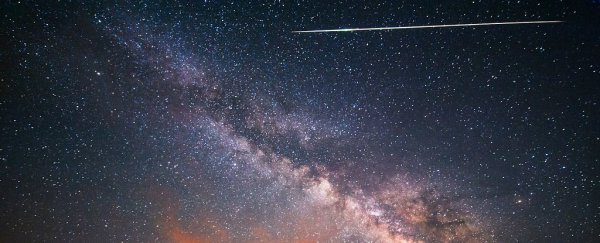While most of us around the planet are sheltering in place right now, we've been spoilt when it comes to the abundance of the night sky.
Last week, the Lyrid meteor shower reached its peak, treating stargazers to up to 20 meteors shooting through the sky per hour. Viewing was best for those in the Northern Hemisphere. But this week, the Southern Hemisphere gets its turn to see even more meteors light up the sky.
We're about to pass through the thickest part of Halley's comet's long dust trail and experience the peak of the annual Eta Aquariid meteor shower.
The shower will peak in the early morning hours of May 6, between 2 and 5 am AEST, (between 16:00 and 17:00 UTC, May 5).
The bad news is the next full moon occurs on May 7, so the sky won't be super dark for optimum viewing during the peak. But the meteors will be raining down most of the week, so you may have more luck catching a glimpse during the slightly darker mornings on either side of the peak.
Southern Hemisphere viewers will be treated to between 20 and 40 meteors per hour, but those in the northern hemisphere - especially people living closer to the equator - should still be able to see 10 to 15 meteors per hour.
Halley's comet was last seen in our skies in 1986 and only circles back every 76 years or so, but it left behind a long trail of ancient dust, which we pass through from April 19 to May 28. But we pass through the thickest debris on the morning of May 6.
We also pass through the debris trail again in October and experience the Orionid shower.
In addition to the almost-full moon lighting up the sky, there are currently three bright planets to contend with. But although this may make it harder to pick out as many meteors, it also means the entire sky will be putting on a show, amateur astronomer Ian Musgrave told the Australian Broadcasting Corporation (ABC).
"It's going to be a really nice night," Musgrave told ABC Science.
"You've got the Milky Way spread out over your head and you're looking down towards Jupiter, Saturn and Mars. If you are really lucky, you should see bright meteors going through the heart of the galaxy."
How to see the Eta Aquariid meteor shower
The shower is named after the faint Eta Aquarii star in the Aquarius Constellation, which acts as its radiant point - the area of the night sky that the meteors appear to emanate from.
To find the best spot to scour the night sky, Bruce McClure from EarthSky.org suggests finding the Aquarius Constellation, and pinpointing its Y-shaped 'Water Jar', which is made up of four stars, including Eta Aquarii.
The water jar is in the southern part of the constellation for those in the Southern Hemisphere, and the northern part for those in the Northern Hemisphere.
"If you can find the Water Jar in the constellation Aquarius, you've as good as located the radiant point for the Eta Aquarid meteors," says McClure.
 Origin of Eta Aquariids as seen from Sydney at 4 am on May 6. (Stellarium/ScienceAlert)
Origin of Eta Aquariids as seen from Sydney at 4 am on May 6. (Stellarium/ScienceAlert)
The best place to view the shower is somewhere away from artificial light where your eyes will have plenty of time to adjust to the dark. No telescopes or binoculars are needed.
But make sure you keep in mind social distancing and shelter in place restrictions in your area - backyard, balcony or rooftop viewing can be just as rewarding. Just remember to set your alarm, grab a hot chocolate, a blanket and enjoy.
